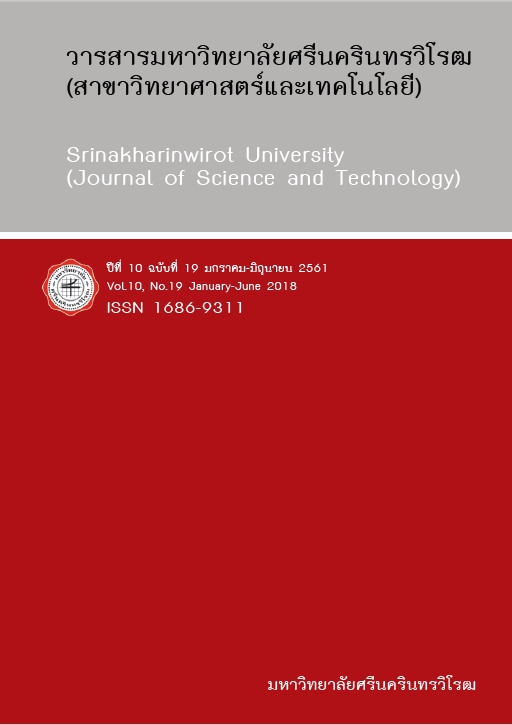ปริมาณที่เหมาะสมของการใช้คอนกรีตเก่าบดละเอียดที่มีขนาดอนุภาคแตกต่างกันสำหรับกำลังอัดสูงสุดของมอร์ตาร์ในงานปูนฉาบ (OPTIMUM USAGE OF RECYCLE CONCRETE WITH DIFFERENT PARTICLE SIZE FOR COMPRESSIVE STRENGTH OF MORTAR PLASTERING)
Keywords:
Optimum Usage, Finely Crushed Recycle Concrete, Particle Size, Compressive Strength, Mortar PlasteringAbstract
This research aims to determine the optimum usage of finely crushed recycle concrete with different median particle sizes for replacing sand for the maximum compressive strength of mortar plastering at 7, 14 and 28 days. Control of percent slump flow at 110±5. The scrap bored piled, design compressive strength of 240 kg/cm2. for converged recycle concrete with the median particle sizes of 0.149-1.190 mm. were used to replace sand at the rate of 0-30% by weight.
The results revealed that increasing of median particlesize offinely crushed recycle concrete caused to the decreasing of compressive strength. The mortar plastering had the maximum compressive strength for sand has been replaced with finely crushed recycle concrete small particle sizes of 0.149-0.297 mm. Andit can be developed to the maximum compressive strength of 109.06 kg/cm2. 135.86 kg/cm2. and 139.15 kg/cm2. The optimum usage of finely crushed recycle concrete as 28%, 30% and 30% for the particle size of small, medium and large respectively
Downloads
References
[2] สุชา กิตติวรารัตน์; และ ภูษิต เลิศวัฒนารักษ์. (2555, ธันวาคม). การจัดการเพื่อลดเศษวัสดุก่อสร้างในงานสถาปัตยกรรมของบ้านพักอาศัยขนาดเล็ก. วารสารวิจัยและสาระสถาปัตยกรรม/การผังเมือง. 9(2): 81-94.
[3] J. M. Khatib. (2005). Properties of concrete incorporating fine recycled aggregate. Cement and Concrete Research. 35(1): 763-769.
[4] สุภาพ ตรีธัญญา. (2542). การนำคอนกรีตที่ใช้แล้วกลับมาแทนวัสดุมวลหยาบในงานก่อสร้าง : กรณีศึกษางานท่อระบายน้ำคอนกรีตไม่เสริมเหล็ก. วิทยานิพนธ์ วท.บ. (เทคโนโลยีการวางแผนสิ่งแวดล้อมเพื่อพัฒนาชนบท). นครปฐม: บัณฑิตวิทยาลัย มหาวิทยาลัยมหิดล.
[5] American Society for Testing and Materials. (2005). ASTM C109/C109M-05 Standard Test Method for Compressive Strength of Hydraulic Cement Mortar (Using 2-in. or [50-mm.] Cube Specimens. Annual Book of ASTM Standard Vol. 4.01, Philadelphia, PA, USA.
[6] American Society for Testing and Materials. (2006). ASTM C807-05 Standard test method for Time of Setting of Hydraulic Cement Mortar by Modified Vicat Needle. Annual book of ASTM Standard. Vol.4.01 Philadelphia, PA, USA.
[7] สถิตย์พงษ์ วงศ์สง่า; และ เรืองรุชดิ์ ชีระโรจน์. (2553). ปริมาณที่เหมาะสมของการใช้เถ้าก้นเตาบดละเอียดที่มีขนาดอนุภาคต่างกันสำหลับกำลังอัดสูงสุดของคอนกรีตทั่งไป. ใน การประชุมวิชาการคอนกรีตประจำปี ครั้งที่ 6. หน้า 273-278. กรุงเทพฯ.
Published
How to Cite
Issue
Section
License
Srinakharinwirot University Journal of Sciences and Technology is licensed Under a Creative Commons Attribution-NonCommercial-NoDerivs 4.0 International (CC-BY-NC-ND 4.0) License, Unless Otherwise Stated. Please Read Journal Policies Page for More Information on Open Access, Copyright and Permissions.



